
Website founded by
Milan Velimirović
in 2006
18:03 UTC


| |
MatPlus.Net  Forum Forum  General General  "no u Chess", as described in the Discord "no u Chess", as described in the Discord |
| |
|
|
|
|
You can only view this page!
| | | (1) Posted by edderiofer [Monday, Jan 25, 2021 13:44] | "no u Chess", as described in the Discord
Some time ago, alshfik from the Chess Problems & Studies Discord Server came up with a bit of a mind-bending fairy condition which we've decided to call "no u Chess". The condition is as follows:
If any non-pawn piece could move to a square on its next turn, then any opponent piece or pawn, on its turn, may capture that piece upon that square. That opponent piece or pawn ends up on that square, and the captured piece is taken off the board as usual. Moving to a square necessarily captures all such pieces in this way. (Regular captures may also be performed, though there is a bit of nuance to this as we'll see later.)
 (= 2+3 ) (= 2+3 )
For example, in this diagram, White is under check from both the Bg8 and the Pf5. If White were to pass the turn, then Black could capture the king on c4 or d5 with the bishop, or on d4 with the pawn, since White is able to move their king to all three of those squares.
It can be deduced that Black's last move must have been f7-f5+. If it weren't for the fact that this does not remove the bishop check, gxf6 e.p. would of course be legal.
White only has one legal move to get them out of check, and that is Kx(Bg8)c4; since the bishop could move to c4 on its next turn, White may move their king there to capture the bishop. No other White move disallows it from stepping onto a square under attack on its next turn.
If the bishop were not there, White would still be unable to play Kxe4, because pawns can't be "no u"-captured.
 (= 1+4 ) (= 1+4 )
In this diagram, White is under double-check from the bishop and rook. White's only move here is Kx(Rg3,Bh7)d3, capturing both the bishop and the rook at the same time.
White is *not* under check from the pawn at d7 because pawns must capture moving diagonally, and therefore the pawn cannot capture on d5. (It could still *move normally* to d5, were it Black's move and the bishop and rook not on the board. Doing so would give check since it would then be attacking c4 and e4, both squares which the king could move to on its next turn.)
If the Black king were on f1 instead of g1, note that Kx(Rg3,Bh7)d3 puts White in check from Black's king, since Kx(Kd3)e2 then follows.
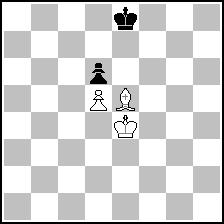 (= 3+2 ) (= 3+2 )
In this diagram, White is presently not in check. Because White is unable to play Ke5 due to their bishop already being on e5, Black playing dxe5 does NOT capture the king in this manner, or any other piece that defends e5. (Note that an en-passant capture in some hypothetical other position could still capture other pieces at the same time, since the destination square is vacant.)
However, we have the interesting consequence that White is unable to move the bishop (except to take the pawn), because that puts them in check from the pawn!
---
Hopefully I've described the rules clearly enough that you now understand what this condition is. If there are any edge cases we haven't mentioned or found yet, feel absolutely free to discuss them.
In the original formulation, stalemate was a loss for the stalemated side, but I feel like that's already a fairy condition somewhere, in which case we can just write both stipulations on any problems.
Anyway, here is a fairly-simple mate-in-two under the "no u Chess" condition:
alshfik
Chess Problems & Studies Discord Server, 2021-01-08
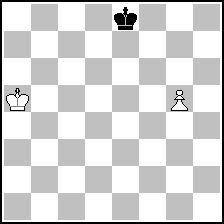 (= 2+1 ) (= 2+1 )
| | | (2) Posted by Sarah Hornecker [Monday, Jan 25, 2021 15:25] |
A small example (with thanks to the entire Discord chat cookhunting and edderiofer bringing the idea of placing the king on the first rank!)
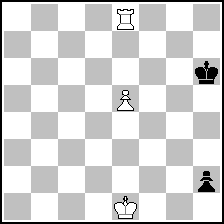 (= 3+2 ) (= 3+2 )
SH, Original
Dedicated to the Discord channel users
White to move and capture Ph2 in two moves
CatinaBox, Original
White to move and checkmate in one move
SH, Original
Remove wPe5, then checkmate in one move
SH (capture Ph2 in 2):
1.Rg8+ h:g1R/B/N 2.K:f1/K:f2/K:e2
CatinaBox (#1):
1.Re6 mate
SH (#1 without Pe5):
Pam-Krabbé castling
EDIT: The #1 without Pe5 does not work, as P/K castling is wKe3/Re2, not wKe7/Re6. Thanks to Joost de Heer!
| | | (3) Posted by Hauke Reddmann [Monday, Jan 25, 2021 16:31] |
Assorted ponderings:
Castling is a K move, as usual, right?
Orthodox e.p. might forbidden due to self-check,
this might get worse in no-u. This calls for fun
=2...(see below)
Can u no-u more than 16 pieces in a single move?
(Obviously no cascading no-u moves should be allowed:
Bh1 - Rg8 Rh8, after Ba8 the Rh8 survives.)
The name is very nondescript, at least you could
have called it Y U NO? :-)
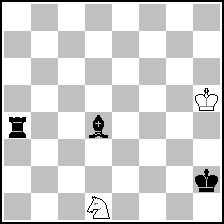 (= 2+3 ) (= 2+3 )
White is stalemated, right?
| | | (4) Posted by Joost de Heer [Monday, Jan 25, 2021 17:21] |
Why is the P/K castling mate in c)?
| | | (5) Posted by Sarah Hornecker [Monday, Jan 25, 2021 17:25] |
Because I say so. :-)
Also because the white king from e7 protects g6 (via f7/f6) from the king, and Black can only take the rook on g6.
| | | (6) Posted by Joost de Heer [Monday, Jan 25, 2021 17:26] |
You do realise that the P/K castling results in wKe3 and wRe2, and not wKe7/wRe6, do you?
| | | (7) Posted by Sarah Hornecker [Monday, Jan 25, 2021 17:28] |
Oops! I somehow had that wrong in my head.
| | | (8) Posted by edderiofer [Monday, Jan 25, 2021 17:36] |
@Hauke Yep, White is stalemated in that position! I genuinely hadn't even considered *that*. Looks like there's plenty to explore here.
Castling is, as usual, a king move. You can't castle into or through check, though, so I'm pretty sure that means you can't capture while castling in no u Chess.
| | | (9) Posted by Hauke Reddmann [Monday, Jan 25, 2021 20:55] |
@eddie: Yes, those were about my thoughts on that.
| | | (10) Posted by Joost de Heer [Tuesday, Jan 26, 2021 07:28] |
Why is Sb2 in Hauke's position illegal?
| | | (11) Posted by edderiofer [Tuesday, Jan 26, 2021 09:17] |
Because it automatically captures the Bd4, putting White in check!
| | | (12) Posted by Joost de Heer [Tuesday, Jan 26, 2021 10:07] |
QUOTE
If any non-pawn piece could move to a square on its next turn, then any opponent piece or pawn, on its turn, may capture that piece upon that square.
That says 'may', not 'must'. So Sb2 without capture is, as far as I can see, a legal move.
| | | (13) Posted by Rosie Fay [Tuesday, Jan 26, 2021 10:07] |
I'm sorry, but the OP's explanation was very unclear. An opponent's piece or pawn can't do anything, because they're the opponent, so it's not their turn. You can't say of a position what the opponent may do when it becomes their turn, because by that time the position will be different. You have to say of a position what the turn player may do now.
Am I right in thinking that a move to square X captures any opposing piece (not pawn; "Figur" in German) which guards X?
Consider the first diagram, OP says "If White were to pass the turn, then Black could capture the king on c4 or d5 with the bishop, or on d4 with the pawn, since White is able to move their king to all three of those squares." But White is not able to move wK to any of those squares, because Black guards all three of those squares. If I've understood right, what puts wK in check from bB is that Black has just threatened Bd5 and Bc4, each of which captures wK, because, in chess, KxB would then become legal. Not because Kc4 and Kd5 are legal now, because they are not.
So the rule on check needs clarifying, I think.
If I've understood right, in Hauke's position, moves by wN are illegal because each such move is to a square guarded by bB, and thus removes bB from d4, thus opening a line from bRa4 to g4 and h4. This puts wK in check because Black moves Rg4 and Rh4 allow KxR in chess, and thus capture wK in this variant. (Which accords with edderiofer's later post, which wasn't displayed to me when I started writing mine. Thank you, edderiofer.)
Let's check if I've understood:
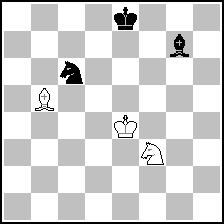 (= 3+3 ) (= 3+3 )
White to move. Is White in check? Black threatens Be5 and Bd4, but it would be illegal for White to parry with KxB in chess, because wK would still be in check from bN. White Kd4 or Ke5 removes bB and bN because pinned units can check. White Ne5 removes bB because bB guards e5, but does not remove bN because pinned units cannot move off the pin line.
 (= 2+3 ) (= 2+3 )
White to move. White appears to not be in check because Black does not threaten a check which in chess White could parry by capturing the checking piece with wK. This because after ...Rf2+ in chess, Kxf2 would be illegal and Bxf2 is of no account.
Is this correct?
| | | (14) Posted by edderiofer [Tuesday, Jan 26, 2021 12:29] |
QUOTE
That says 'may', not 'must'. So Sb2 without capture is, as far as I can see, a legal move.
I didn't say "must" because I'd have taken that to mean that, if a player is able to make any no u capture on their move, they must make that capture instead of making a non-capturing move elsewhere. I see where the confusion comes from, though, and I'm not sure how best to word it for the right intent without specifying "Moving to a square necessarily captures all such pieces in this way." as I did. Advice?
QUOTE
An opponent's piece or pawn can't do anything, because they're the opponent, so it's not their turn. You can't say of a position what the opponent may do when it becomes their turn, because by that time the position will be different. You have to say of a position what the turn player may do now.
Fair point. More accurately, then, I believe I mean that if any non-pawn piece attacks a square (where "attacks" is in the sense of FIDE Article 3.1; Articles 3.8a and 3.8b(2)[a] suggest that a player's pieces continue to attack a square even when it is not their turn (although, come to think of it, article 3.8a should be reworded as "by moving to any adjoining square" for the purposes of determining whether a piece attacks a square)), then an opponent piece or pawn, on its move, may capture that piece upon that square. At least, I *think* that wording captures the intent, but after looking at your example positions, I'm not immediately so sure.
QUOTE
Am I right in thinking that a move to square X captures any opposing piece (not pawn; "Figur" in German) which guards X?
Not quite. If X is occupied, then capturing the piece on X does not capture its guards (because its guards aren't technically attacking X because there's already a friendly piece there). Further, moving a pawn one or two spaces forwards into X does not capture, because pawns only capture moving diagonally.
QUOTE
But White is not able to move wK to any of those squares, because Black guards all three of those squares.
It is still the case that the wK presently attacks all three of those squares, as I'm interpreting it, anyway.
QUOTE
White to move. Is White in check?
I'd say "yes", because the wK attacks e5 and d4 by the above definition. I think. But your stated reasoning for White not being in check could lead to a different interesting fairy condition. Hmm.
QUOTE
White to move. White appears to not be in check because...
Under my intent, White is in check because White's king attacks f1, f2, and f3 even if it's illegal for White to actually move their king there. The bishop here is immaterial. Again, though, your stated reasoning for White not being in check could lead to a different interesting fairy condition.
---
...and I've just noticed that my rules as stated seem to contradict my statement about forward pawn moves not also capturing. This is going to be a nightmare to rewrite.
| | | (15) Posted by Joost de Heer [Tuesday, Jan 26, 2021 12:47] |
There's a difference between 'possible moves' (piece X can move to square Y according to the rules of movement) and 'legal moves' (possible moves + legality check).
If a player moves an officer to a square X, all opponent officers which could have moved to that square if the opponent had the move are captured. Legality is tested after all the captures are done.
It's a form of make&take chess (where white captures by first moving as the to-be-captured piece and then captures this piece moving normally).
| | | (16) Posted by edderiofer [Tuesday, Jan 26, 2021 12:53] |
Thank you, Joost, that's a way better way of stating what I had in mind.
| | | (17) Posted by seetharaman kalyan [Monday, Feb 1, 2021 21:01] |
Very interesting fairy condition. I wish you could give it a more descriptive name... like "move-to- capture" or "magic capture"
| |
No more posts |
MatPlus.Net  Forum Forum  General General  "no u Chess", as described in the Discord "no u Chess", as described in the Discord |
|
|
|
 ISC 2024
ISC 2024 Forum
Forum  General
General  "no u Chess", as described in the Discord
"no u Chess", as described in the Discord 


